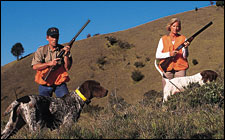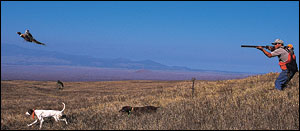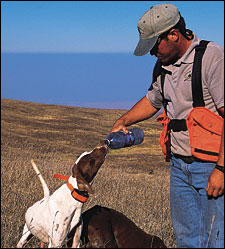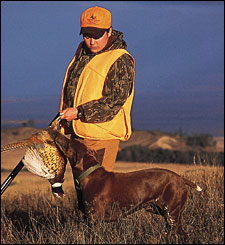The 50th state offers much more than sun, beaches and waves
By Gary Kramer
The pointer and German shorthair ranged far and wide in the brush and grass-covered landscape, covering a tremendous amount of ground with each sweep. The rolling hills were bisected with long narrow valleys and deep draws. Fifteen minutes from the vehicle, the dogs disappeared over a hill and into a long valley. When they didn't come out the other side, Patrick Fisher pointed toward the draw and said, "We need to get down there right away. I think the dogs are on point." My daughter Kelly and I quickened the pace through the dense grass and scattered shrubs, mindful of the uneven footing over the lava rocks.
Patrick spotted the dogs first--both solid as statues, one backing the other at the bottom of a draw. Patrick motioned me in behind the lead dog. As I stepped next to the pointer, a close-flushing rooster catapulted from the tall grass. For a moment I was oblivious to my surroundings--my only focus was the rooster in front of me.
Just as the bird cleared the grass, a second cock flushed from the same spot. I shouldered my 20-gauge over/under, found a target, pulled the trigger and the bird folded in a spray of feathers. Before I could find a second target, there was another shotgun blast and out of the corner of my eye I watched the second rooster catch a full load of No. 6s and fall out of sight into the draw.
Kelly and I congratulated each other on our shooting skill while Mea, the German shorthair, found the first pheasant and delivered it to Patrick. We walked to where the second bird dropped and a few minutes later Mea pulled the bird out from under a patch of brush. Upon closer inspection we agreed--the rooster looked and acted like a South Dakota ringneck but a glance toward the blue Pacific below and snow-capped Mauna Kea behind us verified we were miles from Dakota cornfields--we were hunting pheasants in Hawaii.
 A bird hunt in Hawaii is truly a spouse-friendly vacation. |
HAWAIIAN HABITAT
The Hawaiian Islands are synonymous with sparkling white sand beaches, tropical rain forests, live volcanoes and the tourist attractions of Waikiki. For these reasons and more, Hawaii is one of the world's most popular tourist destinations. However, for all the reasons Hawaii is considered the ultimate vacation spot, upland bird shooting is seldom considered. The truth is, the Hawaiian Islands offer some of the most unique bird hunting in North America.
Ranging in size from tiny Lanai, whose land mass is only 90,000 acres, to the "Big Island" of Hawaii, which covers an area the size of Connecticut, Hawaii consists of six major islands. Each island has a wide variety of habitats ranging from tropical rain forests and rolling grasslands to acacia thorn forests and lava slopes. This diversity of habitat, stretching from sea level to 13,796 feet at the top of Mauna Kea, provides habitat for 15 species of upland game birds.
In the late 1700s when Captain Cook first set foot on the Hawaiian Islands, there were no upland game birds. Ring-necked pheasants were the first introductions with birds from Asia liberated as early as 1875. Ringnecks found the Islands to their liking and through subsequent liberations spread to all six islands. Today, the ringneck is Hawaii's most widespread game bird and inhabits dry cactus and mesquite habitats near sea level to forested grasslands at 7,000 feet.
 Two gunners draw down on a flushing pheasant. |
Other successful introductions include chukar, found on Hawaii, Maui and Lanai; California quail, whose largest populations are on Molokai and Hawaii; Gambel's quail on Lanai; mourning doves on Hawaii and wild turkeys on Lanai, Molokai and Hawaii. Other more exotic species include gray francolin from Asia, black and Erkel's francolin from Africa, green pheasants from Japan, Kalij pheasants from Tibet, Japanese quail, African sandgrouse and two species of Asian doves.
All six islands allow bird hunting from the first Saturday in November through Martin Luther King Day in January. Hunting in Hawaii is permitted only on Saturdays, Sundays and state holidays. The weekend-only hunting law is antiquated and has been challenged several times without success. An exception to the weekend/holiday-only rule occurs on the Big Island where hunting is permitted on Wednesdays as well, and on all hunting preserves where shooting is permitted seven days per week during a September to March season.
Last January, Kelly and I spent a week on the island of Hawaii hunting upland birds. It was the tail end of Kelly's winter break from college and when I asked her if she was interested in a few days bird hunting mixed with the sun, sand and aloha atmosphere of Hawaii, she jumped at the chance.
The first pair of pheasants was in the bag, so we headed cross-country toward a cattle trough where Patrick had seen good numbers of Erkel's francolin going to water the past few mornings. The habitat was a mixture of scattered shrubs, lava rock and open grassland. The vegetation and the sight of the dogs working the area reminded me of gray partridge hunting in southwest Idaho.
As we came within a quarter-mile of the water trough, Patrick's pointer Kana abruptly stopped and assumed the classic pose with head forward, back straight and tail high. Mea moved in and honored the point. Patrick motioned Kelly and me to move in behind the dogs. The moment Kelly reached the dogs, a gray bombshell exploded from the grass. She shouldered her 20-gauge auto, squeezed the trigger and the first francolin of the trip hit the ground.
The second bird was a delayed flush that came up on my side. I swung hard right and missed clean with my first barrel. The bird ducked behind a patch of brush before I could fire a second round and flew off untouched. Kelly's bird was a mature cock Erkel's francolin, an African game bird related to northern hemisphere partridges. It was about the size of a pheasant with a short tail, chestnut crown and whitish throat. It had yellow legs and double spurs, making it an impressive bird in the hand.
 A respite for a couple of pointers. It's good to have a handy water bottle to keep the dogs hydrated. |
Now we knew better what to expect and headed off across the grass- and rock-covered land
scape. For the next hour we worked the hillsides and draws with the pointers finding birds on a regular basis. Most of them held in pairs and small groups of up to six while a few flushed wild. It was like hunting Huns or sharptails in grass and brush cover with virtually every bird shot in front of a seasoned and steady pointer. By the time we stopped to water the dogs at 9:00 a.m. we had our three-bird limits of Erkel's francolin.
The truck was more than a mile away and we headed in that direction. As we skirted a draw lined with brush, Kana went on point. I dropped into the draw to investigate, fully expecting to find another francolin. I was surprised when a covey of 20 California quail flushed in front of the dog. While the majority of the covey flushed wild and too far away for a shot, a single bird followed the edge of the draw and flew toward me before going vertical to clear the steep slope. I managed to catch up with the fleeing target, anchoring the first California quail of the trip. With pheasants, francolin and now quail in possession, we were on our way to a true mixed bag.
On the way back to the pick-up, the dogs found several Erkel's francolin and a couple of hen pheasants. Each time we walked up on the dogs, we were hoping for another covey of quail or a rooster pheasant. Just before we reached the pick-up, Patrick suggested we work a series of lava ridges where he had seen quail in the past.
Kana was working a rocky outcrop when she bumped a covey of chukars that flushed out of gun range. Patrick was a bit upset with the dog but pleased we had located a covey of chukars in an area where he had seen them only on one other occasion. We watched as they flew downhill to a jumble of rocks at least a quarter-mile away. Kelly, Patrick and I headed downhill with no hesitation toward the birds. Patrick called the dogs in and kept them at heel until we reached the area we saw the birds land.
 Enjoying the fruits of labor. Kelly, the author's daughter allows German shorthair Mia to sniff a pheasant. |
Fifteen minutes later, the dogs were working the cover when Mea went on point. Almost at the same moment Kana went on point as well but 100 yards in the opposite direction. We decided to split up and investigate both points. I came in below Mea but nothing happened. Patrick released the dog and she crept forward, then stopped, and then crept forward again. Nearly 100 yards up the hill, the dog finally pushed the birds hard enough for them to hold momentarily before flushing.
Suddenly, there were a dozen chukar flushing all around me and I struggled to pick a target. I swung on a target going straight away, found my mark and fired, anchoring the bird. A late-flushing chukar provided another opportunity but my second shot missed the mark. Nonetheless, I was happy to add another species to the bag.
Meanwhile, Kelly moved in on Kana and put up another Erkel's, which she watched fly off then apologized to the dog for not shooting. Somehow the dog didn't appreciate the fact she already had a limit of Erkel's francolin in her game bag.
We finally reached the vehicle, loaded up the dogs and birds and drove back to Patrick's house for a midday break and lunch. His house is located just off the Saddle Road on the Parker Ranch, a 185,000-acre working cattle ranch founded in 1847 on the Big Island of Hawaii.
| Planning Your Hawaii Hunt | 

To book hunts on the Big Island, contact Patrick Fisher, Parker Ranch, 67-1435 Mamalahoa Hwy. Kamuela, HI 96743; (808) 885-2313 or (808) 870-4868; www.parkerranch.com. Hunters must posses a hunter safety certificate in order to purchase a nonresident Hawaii hunting license. A hunting license from your state of origin won't suffice.
A hunter safety certificate is not required to hunt on shooting preserves; all that's needed is a hunting license from your home state. Regulations and information are available from the Hawaii Division of Forestry and Wildlife, (808) 587-0166; www.dofaw.net. General information and a travel planner are available from the Hawaii Visitors and Convention Bureau, (800) 464-2924; www.gohawaii.com.
|
|
In recent years, the ranch has diversified their operations by offering day hunts for big game (mouflon sheep, feral sheep, feral goats and wild boar), both day shoots and season memberships for birds, and have established a bird shooting preserve.
The hunting/wildlife management operation on the Parker Ranch is run by Patrick Fisher, who formerly ran the Ulupalakua Hunting Club on Maui. Since he took over the operation in the spring of 2001, he has diligently worked on the habitat management aspect of the operation and has put in water developments, food plots and modified grazing programs.
With 185,000 acres, the hunting areas on the Parker Ranch are nearly unlimited and range in elevation from near sea level to more than 8,000 feet. On my recent trip we enjoyed mixed-bag shooting in brush and grass habitat at about 4,000 feet, excellent hunting for gray and black francolin at 1,000 feet in the Kohala region, and chukar in the shadow of Mauna Kea near 7,000 feet. Limits are liberal with three ringnecks, three Erckel's francolin, eight black francolin, gray francolin or chukar (all one species or in combination) and 15 California quail.
The 2002-2003 season was one of the best in the past decade. Limits were the rule rather than the exception and bird populations were high. Until the spring of 2002, the Hawaiian Islands had experienced various stages of a long-term drought. The dry conditions reduced bird populations throughout the Islands and devastated them in some areas. The spring of 2002 was wet and the long awaited moisture came at the perfect time to trigger tremendous bird hatches. As a result, I observed at least a threefold increase in the game bird populations on the Big Island compared to previous years.
In addition to wild birds, the Parker Ranch operates a pheasant and chukar preserve with hunting available from early October to late February. The birds are raised in the Islands and exhibit excellent flight characteristics. The difference between the preserve birds and the wild birds was undetectable.
Finally, it must be noted that a bird hunt in Hawaii is truly a spouse-friendly vacation. It's easy to hunt birds for a half day or full day and still be back at one of the beach resorts for afternoon cocktails and dinner with your significant other. Your spouse can enjoy the warm weather, beaches and the varied recreation the Islands have to offer while you are enjoying some of the best bird hunting in North America.






